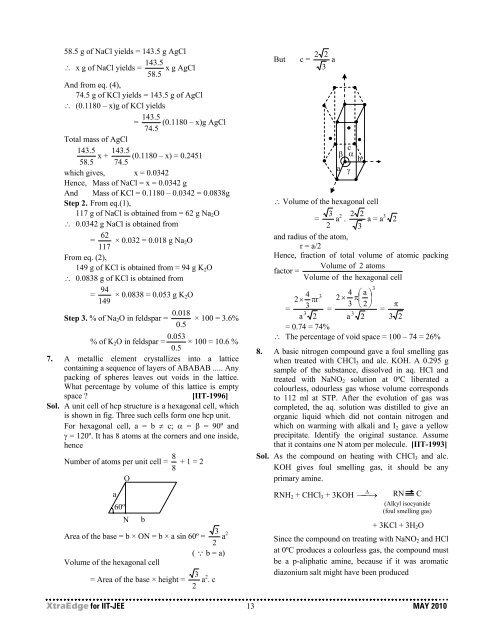Create successful ePaper yourself
Turn your PDF publications into a flip-book with our unique Google optimized e-Paper software.
58.5 g of NaCl yields = 143.5 g AgCl<br />
143.5<br />
∴ x g of NaCl yields = x g AgCl<br />
58.5<br />
And from eq. (4),<br />
74.5 g of KCl yields = 143.5 g of AgCl<br />
∴ (0.1180 – x)g of KCl yields<br />
143.5<br />
= (0.1180 – x)g AgCl<br />
74.5<br />
Total mass of AgCl<br />
143.5 143.5<br />
x + (0.1180 – x) = 0.2451<br />
58.5 74.5<br />
which gives, x = 0.0342<br />
Hence, Mass of NaCl = x = 0.0342 g<br />
And Mass of KCl = 0.1180 – 0.0342 = 0.0838g<br />
Step 2. From eq.(1),<br />
117 g of NaCl is obtained from = 62 g Na 2 O<br />
∴ 0.0342 g NaCl is obtained from<br />
62<br />
= × 0.032 = 0.018 g Na2 O<br />
117<br />
From eq. (2),<br />
149 g of KCl is obtained from = 94 g K 2 O<br />
∴ 0.0838 g of KCl is obtained from<br />
94<br />
= × 0.0838 = 0.053 g K2 O<br />
149<br />
0.018<br />
Step 3. % of Na 2 O in feldspar = × 100 = 3.6%<br />
0.5<br />
0.053<br />
% of K 2 O in feldspar = × 100 = 10.6 %<br />
0.5<br />
7. A metallic element crystallizes into a lattice<br />
containing a sequence of layers of ABABAB ..... Any<br />
packing of spheres leaves out voids in the lattice.<br />
What percentage by volume of this lattice is empty<br />
space ?<br />
[<strong>IIT</strong>-1996]<br />
Sol. A unit cell of hcp structure is a hexagonal cell, which<br />
is shown in fig. Three such cells form one hcp unit.<br />
For hexagonal cell, a = b ≠ c; α = β = 90º and<br />
γ = 120º. It has 8 atoms at the corners and one inside,<br />
hence<br />
Number of atoms per unit cell = 8<br />
8 + 1 = 2<br />
O<br />
a<br />
60º<br />
N b<br />
3<br />
Area of the base = b × ON = b × a sin 60º = a<br />
2<br />
2<br />
( Q b = a)<br />
Volume of the hexagonal cell<br />
3<br />
= Area of the base × height = a 2 . c<br />
2<br />
But c =<br />
2 2<br />
a<br />
3<br />
c<br />
β α<br />
b<br />
a γ<br />
∴ Volume of the hexagonal cell<br />
3<br />
= a 2 2 2<br />
. a = a 3 2<br />
2 3<br />
and radius of the atom,<br />
r = a/2<br />
Hence, fraction of total volume of atomic packing<br />
Volume of 2 atoms<br />
factor =<br />
Volume of the hexagonal cell<br />
4 4 ⎛ a ⎞<br />
3<br />
2×<br />
πr<br />
2 × π⎜<br />
⎟<br />
=<br />
3 3 2<br />
=<br />
⎝ ⎠ π<br />
=<br />
3<br />
3<br />
a 2 a 2 3 2<br />
= 0.74 = 74%<br />
∴ The percentage of void space = 100 – 74 = 26%<br />
8. A basic nitrogen compound gave a foul smelling gas<br />
when treated with CHCl 3 and alc. KOH. A 0.295 g<br />
sample of the substance, dissolved in aq. HCl and<br />
treated with NaNO 2 solution at 0ºC liberated a<br />
colourless, odourless gas whose volume corresponds<br />
to 112 ml at STP. After the evolution of gas was<br />
completed, the aq. solution was distilled to give an<br />
organic liquid which did not contain nitrogen and<br />
which on warming with alkali and I 2 gave a yellow<br />
precipitate. Identify the original sustance. Assume<br />
that it contains one N atom per molecule. [<strong>IIT</strong>-1993]<br />
Sol. As the compound on heating with CHCl 3 and alc.<br />
KOH gives foul smelling gas, it should be any<br />
primary amine.<br />
RNH 2 + CHCl 3 + 3KOH<br />
3<br />
⎯⎯→<br />
∆ RN C<br />
(Alkyl isocyanide<br />
(foul smelling gas)<br />
+ 3KCl + 3H 2 O<br />
Since the compound on treating with NaNO 2 and HCl<br />
at 0ºC produces a colourless gas, the compound must<br />
be a p-aliphatic amine, because if it was aromatic<br />
diazonium salt might have been produced<br />
XtraEdge for <strong>IIT</strong>-<strong>JEE</strong> 13 MAY 2010

















